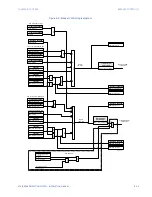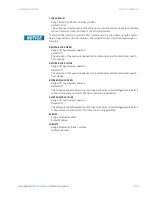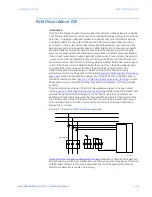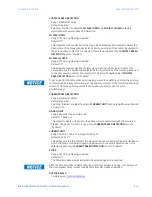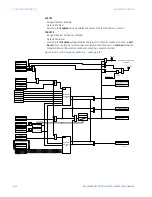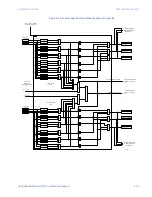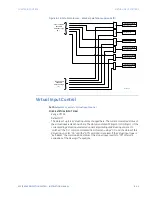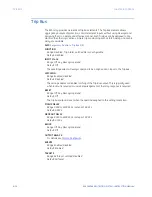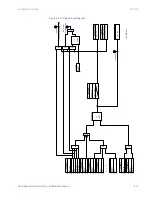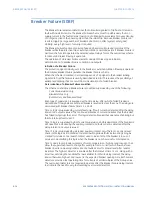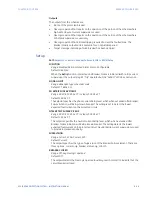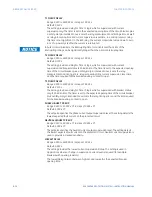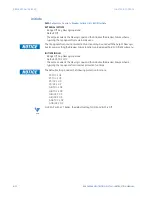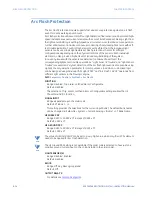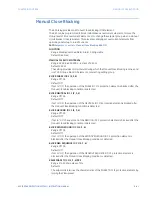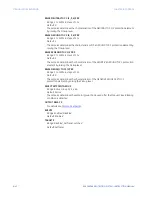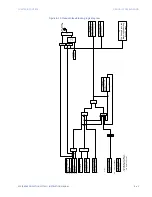
8–28
850 FEEDER PROTECTION SYSTEM – INSTRUCTION MANUAL
BREAKER FAILURE (50BF)
CHAPTER 8: CONTROL
Breaker Failure (50BF)
The Breaker Failure element determines that a breaker signaled to Trip has not cleared a
fault within a definite time. The Breaker Failure scheme must Trip all breakers that can
supply current to the faulted zone. Operation of a breaker Failure element causes clearing
of a larger section of the power system than the initial Trip. Because Breaker Failure can
result in tripping a large number of breakers and this can affect system safety and
stability, a very high level of security is required.
The Breaker Failure function monitors phase and neutral currents and/or status of the
breaker while the protection trip or external initiation command exists. If Breaker Failure is
declared, the function operates the selected output relays, forces the autoreclose scheme
to lockout and raises FlexLogic operands.
The operation of a Breaker Failure element consists of three stages: initiation,
determination of a Breaker Failure condition, and outputs.
Initiation of a Breaker Failure
The protection signals initially sent to the breaker or external initiation (FlexLogic operand
that initiates Breaker Failure) initiates the Breaker Failure scheme.
When the scheme is initiated, it immediately sends a Trip signal to the breaker initially
signaled to Trip (this feature is usually described as re-trip). This reduces the possibility of
widespread tripping that can result from a declaration of a failed breaker.
Determination of a Breaker Failure condition
The schemes determine a Breaker Failure condition supervised by one of the following:
Current supervision only
Breaker status only
Both (current and breaker status)
Each type of supervision is equipped with a time delay, after which a failed breaker is
declared and Trip signals are sent to all breakers required to clear the zone. The delays are
associated with breaker failure timers 1, 2, and 3.
Timer 1 logic is supervised by current level only. If fault current is detected after the delay
interval, an output is issued. The continued presence of current indicates that the breaker
has failed to interrupt the circuit. This logic detects a breaker that opens mechanically but
fails to interrupt fault current.
Timer 2 logic is supervised by both current supervision and breaker status. If the breaker is
still closed (as indicated by the auxiliary contact) and fault current is detected after the
delay interval, an output is issued.
Timer 3 logic is supervised by a breaker auxiliary contact only. There is no current level
check in this logic as it is intended to detect low magnitude faults. External logic may be
created to include control switch contact used to indicate that the breaker is in out-of-
service mode, disabling this logic when the breaker is out-of-service for maintenance.
Timer 1 and 2 logic provide two levels of current supervision - high-set and low-set - that
allow the supervision level to change (for example: from a current which flows before a
breaker inserts an opening resistor into the faulted circuit to a lower level after resistor
insertion). The high-set detector is enabled after the timeout of timer 1 or 2, along with a
timer low-set delay that enables the low-set detector after its delay interval. The delay
interval between high-set and low-set is the expected breaker opening time. Both current
detectors provide a fast operating time for currents at small multiples of the Pickup value.
The overcurrent detectors are required to operate after the Breaker Failure delay interval
to eliminate the need for very fast resetting overcurrent detectors.
Summary of Contents for Multilin 850
Page 10: ...VIII 850 FEEDER PROTECTION SYSTEM INSTRUCTION MANUAL ...
Page 135: ...CHAPTER 3 INTERFACES SOFTWARE INTERFACE 850 FEEDER PROTECTION SYSTEM INSTRUCTION MANUAL 3 41 ...
Page 151: ...CHAPTER 3 INTERFACES SOFTWARE INTERFACE 850 FEEDER PROTECTION SYSTEM INSTRUCTION MANUAL 3 57 ...
Page 153: ...CHAPTER 3 INTERFACES SOFTWARE INTERFACE 850 FEEDER PROTECTION SYSTEM INSTRUCTION MANUAL 3 59 ...
Page 439: ...CHAPTER 7 MONITORING FUNCTIONS 850 FEEDER PROTECTION SYSTEM INSTRUCTION MANUAL 7 19 ...
Page 644: ...11 20 850 FEEDER PROTECTION SYSTEM INSTRUCTION MANUAL FLEXELEMENTS CHAPTER 11 METERING ...


